
Massimo Side-by-Side Utility Vehicles (UTVs) in Sustainable Agriculture: A Preliminary Assessment
This article explores the potential applications of Massimo side-by-side utility vehicles (UTVs) in sustainable agriculture. While promising, a definitive assessment requires further research and data. This analysis focuses on the potential benefits and limitations based on currently available information. For more information on Massimo UTVs, visit the manufacturer's website.
Maneuverability and Terrain Access: Enhancing Farm Efficiency
Farming often involves navigating challenging terrain and tight spaces. Massimo UTVs, with their compact size and nimble handling, offer improved maneuverability compared to larger tractors. This enhanced access could lead to increased efficiency, particularly on smaller farms or in orchards with complex layouts. However, the extent of these time savings requires further empirical study. Could a more agile machine truly translate into significant productivity gains? This is a question that needs robust field testing to answer definitively.
Precision Agriculture Integration: A Potential Synergy
While not inherently designed for precision agriculture, Massimo UTVs show promise. Many models feature touchscreen displays, suggesting potential integration with GPS systems and farm management software. This integration could enable real-time monitoring of soil conditions, optimized irrigation scheduling, and precise fertilizer application. However, the successful integration and resulting benefits require further investigation and practical demonstrations. Can we quantify the potential yield improvements and resource savings through such integration? More data is needed to support these claims.
Payload Capacity and Task Limitations: Realistic Expectations
A critical factor is the payload capacity of Massimo UTVs. Can they reliably carry the weight of large spray tanks or heavy equipment? Currently, definitive data on this is lacking. For certain tasks, smaller, specialized vehicles or even drones might prove more suitable. Therefore, it's crucial to carefully assess the weight requirements of your farming operations before investing in a Massimo UTV. What is the maximum weight a Massimo UTV can safely carry without compromising stability or performance? This needs to be clarified through manufacturer specifications and independent testing.
Sustainability Considerations: Fuel Efficiency and Environmental Impact
The environmental impact of Massimo UTVs is crucial for sustainable agriculture. Data on fuel efficiency and emissions is currently limited. Lower fuel consumption and reduced emissions are vital for minimizing the environmental footprint of farming. Independent testing is necessary to establish their overall environmental impact and compare these vehicles to existing alternatives. Can we definitively state that Massimo UTVs contribute to reduced greenhouse gas emissions in agricultural operations? Further research is essential for a conclusive statement on their environmental friendliness.
Economic Analysis: Cost-Effectiveness and Return on Investment (ROI)
A comprehensive financial analysis is vital for assessing the cost-effectiveness of Massimo UTVs. This should encompass the purchase price, fuel costs, maintenance expenses, and potential labor savings. A thorough cost-benefit analysis will determine whether the investment justifies the expected return. What is the projected ROI for a Massimo UTV in various farming scenarios? A detailed analysis, considering factors like farm size and operational characteristics, is necessary to predict financial returns accurately.
A Practical Implementation Framework
A phased approach is recommended for integrating Massimo UTVs into farm operations:
- Pilot Program: Implement a small-scale trial to evaluate performance under your specific conditions.
- Data Monitoring: Meticulously track costs (fuel, maintenance) and productivity improvements. Calculate your ROI.
- System Integration: Explore compatibility with existing precision agriculture software and GPS systems.
- Comparative Analysis: Compare Massimo UTVs to alternative equipment options to make an informed decision.
Future Research Needs: Addressing Knowledge Gaps
The full potential of Massimo UTVs in sustainable agriculture depends on further research:
- Comparative Performance: Direct comparisons with other farm vehicles are needed.
- Comprehensive Cost Analysis: Long-term cost projections are crucial for financial decision-making.
- Environmental Impact Assessment: Independent testing should quantify fuel efficiency and emissions.
- Real-World Case Studies: Documenting practical applications across diverse farming contexts.
These research efforts will provide a clearer understanding of the role Massimo UTVs can play in the future of sustainable agriculture. Only then can we definitively assess their value and impact.